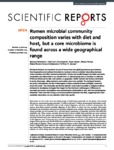Use este identificador para citar ou linkar para este item:
http://www.alice.cnptia.embrapa.br/alice/handle/doc/1035993Registro completo de metadados
| Campo DC | Valor | Idioma |
|---|---|---|
| dc.contributor.author | HENDERSON, G. | pt_BR |
| dc.contributor.author | COX, F. | pt_BR |
| dc.contributor.author | GANESH, S. | pt_BR |
| dc.contributor.author | JONKER, A. | pt_BR |
| dc.contributor.author | YOUNG, W. | pt_BR |
| dc.contributor.author | GLOBAL RUMEN CENSUS COLLABORATORS | pt_BR |
| dc.contributor.author | JANSSEN, P. H. | pt_BR |
| dc.date.accessioned | 2016-02-03T11:11:11Z | pt_BR |
| dc.date.available | 2016-02-03T11:11:11Z | pt_BR |
| dc.date.created | 2016-02-03 | pt_BR |
| dc.date.issued | 2015 | pt_BR |
| dc.identifier.citation | Nature, Scientific Reports 5, article 14567, 2015. | pt_BR |
| dc.identifier.uri | http://www.alice.cnptia.embrapa.br/alice/handle/doc/1035993 | pt_BR |
| dc.description | Ruminant livestock are important sources of human food and global greenhouse gas emissions. Feed degradation and methane formation by ruminants rely on metabolic interactions between rumen microbes and affect ruminant productivity. Rumen and camelid foregut microbial community composition was determined in 742 samples from 32 animal species and 35 countries, to estimate if this was influenced by diet, host species, or geography. Similar bacteria and archaea dominated in nearly all samples, while protozoal communities were more variable. The dominant bacteria are poorly characterised, but the methanogenic archaea are better known and highly conserved across the world. This universality and limited diversity could make it possible to mitigate methane emissions by developing strategies that target the few dominant methanogens. Differences in microbial community compositions were predominantly attributable to diet, with the host being less influential. There were few strong co-occurrence patterns between microbes, suggesting that major metabolic interactions are non-selective rather than specific. | pt_BR |
| dc.language.iso | eng | eng |
| dc.rights | openAccess | eng |
| dc.subject | Ruminant digestion | pt_BR |
| dc.subject | Metabolism of ruminant | pt_BR |
| dc.title | Rumen microbial community composition varies with diet and host, but a core microbiome is found across a wide geographical range. | pt_BR |
| dc.type | Artigo de periódico | pt_BR |
| dc.date.updated | 2016-02-19T11:11:11Z | pt_BR |
| riaa.ainfo.id | 1035993 | pt_BR |
| riaa.ainfo.lastupdate | 2016-02-19 | pt_BR |
| dc.contributor.institution | Gemma Henderson, AgResearch Limited, New Zealand; Faith Cox, AgResearch Limited, New Zealand; Siva Ganesh, AgResearch Limited, New Zealand; Arjan Jonker, AgResearch Limited, New Zealand; Wayne Young, AgResearch Limited, New Zealand; Global Rumen Census Collaborators; Peter H. Janssen, AgResearch Limited, New Zealand. | pt_BR |
| Aparece nas coleções: | Artigo em periódico indexado (CNPGL)  | |
Arquivos associados a este item:
| Arquivo | Descrição | Tamanho | Formato | |
|---|---|---|---|---|
| Cnpgl2015NatureRumen.pdf | 1.65 MB | Adobe PDF |  Visualizar/Abrir |









